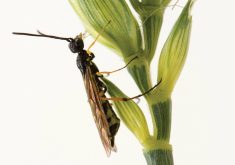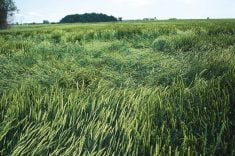Aphids may be nearly invisible to the untrained eye, but a research scientist who specializes in crop-destroying insects warns Saskatchewan farmers not to turn their backs on the tiny, pear-shaped pests.
Tyler Wist, a field crops entomologist with Agriculture and Agri-Food Canada in Saskatoon, spoke about the threat aphids can pose to some crops at the recent Saskatchewan Agronomy Update conference.
Wist says aphid populations can “explode” in a short period of time and can pose a serious risk to small grain and pulse crops if left unchecked. In 2024, his department received multiple reports of aphid damage from several regions of the province.
Read Also

Claas brings 1000 Series SP forage harvesters to Canada
In mid-August, Claas unveiled its new line of Jaguar forage harvesters at an event in Visalia, California, deep in the heart of that state’s dairy region.
A large part of the threat aphids pose is the fact that they reproduce quickly and can build up their populations very fast. For example, pea aphid populations in pulse crops can double in a matter of just five or six days.
“That’s why I say don’t turn your back on aphids. You can check them one week and then you come back the next week and all those aphids have reproduced. All those aphids that were there before, they’ve now had a chance to feed on your crop, plus now you got all these new aphids” causing damage, he says.
“If you have aphids in your field, keep an eye on them.”
The three most common types of crop-damaging aphids found in Saskatchewan are pea aphids, English grain aphids and bird cherry-oat aphids. English grain and bird cherry-oat aphids are most commonly found in small grains such as barley and oats while pea aphids favour pulse crops including faba beans, lentils and peas.
Aphids cause damage by sucking sap from within the plant. In the case of pulses, if the plant becomes stressed during the flowering stage, it can drop its flowers and seed pods fail to develop as a result.
Wist’s advice to growers is to start scouting for aphids in pulses and small grains by the second week of July, as that’s when their populations typically start to grow. English grain aphids can usually be found in the head of a cereal plant where the seed is starting to fill. Bird cherry-oat aphids can be found in the head but other parts of the cereal plant as well. Their populations can be patchy, which is why Wist says it’s recommended that between 50 and 100 plant heads are checked during scouting.

Make sure they’re dead
There are several measures growers can take to help control aphid populations in their fields.
One of the methods researchers in Saskatchewan have been studying is the impact of plant timing on aphid populations. That includes early planting (mid-May), medium planting (late May) and late planting (early June). Preliminary results indicate crops seeded early tend to have fewer problems with aphids compared to those seeded later in the season.
“Those (late) ones always yielded far worse then than the earlier-planted ones,” says Wist. “Whether or not it was due to aphids, or had something to do with not enough heat units or degree days to get the yield out, we don’t know for sure. But every year the late-planted ones yielded terribly.”
To spray or not to spray is a question many farmers ask when dealing with aphids. Wist points out it can depend on the type of crop being grown. In the case of small grains, once the plant has reached the soft dough stage and the grain has filled, aphids can’t cause any more damage to the plant, so spraying is no longer required.
READ MORE: Keeping aphids in check, online and off
It’s more difficult to assess in pulse crops, he adds, since there’s no evidence to indicate a “stop point” where aphids can’t do any more damage to a plant, and in peas, the older stages have a higher tolerance for pea aphids, as shown by a higher economic threshold.
If you’re going to spray for aphids, Wist recommends conducting a follow-up inspection of the field that has been sprayed, to make sure the pesticide that was used had the desired effect.
“When you spend all that time and money to spray your field and nothing happens to the population when it’s sprayed, it’s frustrating,” he says. “Go back and check after the label says you can go back in the field. Go back and check to make sure that those aphids actually died when (you) sprayed.”
Wist says one area of concern regarding the use of pesticides to control aphids is that they appear to be developing some resistance to some pyrethroids, including lambda-cyhalothrin.
Prairie predators
Beneficial insects can also play an important role in controlling aphids in the field, according to Wist.
Golden-eyed lacewing flies are ferocious predators that feast on pea aphids and kill them by sucking out their innards. Braconid wasp larvae like to gorge themselves on aphids. They kill hosts by laying their eggs inside them, which then hatch with the offspring eating the aphid from the inside out, then cutting a hole in the back end of the host to escape. Lady beetles are also effective aphid killers and can eat as many as 50 to 85 aphids in a day.
Recent research conducted at the University of Calgary indicates one of the spinoff benefits of beneficial pollinating insects being present in a field is that they can cause a spike to yield in many cases due in part to the cross-pollination they promote. That cross-pollination can also help a crop stand to set more evenly and mature more consistently.
Wist says one way farmers can boost the presence of beneficial insects in their fields is to convert unproductive areas into refuges that can help attract them. However, he cautions growers “not to put all their eggs in one basket” and to use whatever integrated pest management tools are available to them to control aphids.

Aphids ahoy?
Predicting when aphids could be a problem is difficult to do, since they tend to migrate from one location to another due to winds. In addition, Wist’s recent data indicate pea aphids may be overwintering on perennials such as alfalfa. The good news in that case, Wist says, is that cold winter temperatures could keep those populations under control.
As for whether aphids could be a threat in 2025, Wist says that will depend largely on weather conditions during the growing season. Aphids tend to prefer mild temperatures around 20 C which is typically when they thrive. Aphids won’t reproduce and can quickly die out when average temperatures are sustained around 30 C or warmer, he adds — like what happened in 2021 under July’s “heat dome.”
















